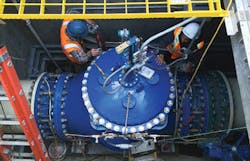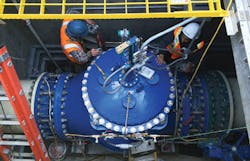By Ryan Spooner and Clint Smith
The Bull Run watershed has continuously provided water to the Portland, Ore., metropolitan area since 1895. It also plays an important role in supporting the larger aquatic ecosystem of the Sandy and Lower Columbia rivers, where some of the fish species have been in significant decline.
The problem was that the water temperature of the Sandy River was too warm during summer months, making it difficult for the fish to spawn. A plan was therefore put in place to change the location of the source that feeds the lower river from the warmer top layer to the cooler waters in the lower part of the dam.
To do this would require a distribution system that would control the amount of cold water entering the system by setting a desired flow rate of cold water. The control system needed to have the capability of measuring flow, as well as the capacity to handle changing flows, from low flows to upwards of 83,000 gallons per minute (GPM).
Given that the reservoir fill height has an inlet pressure of 45 psi and that the water flows into the river at atmospheric pressure, the valve control system had to be able to withstand a 45-to-0 psi pressure drop.
The solution was to use two Singer S106-2SC-PCO-MV-C-AC valves with an MCP-TP Control Panel. This valve has dual solenoids in the pilot system, which allows the MCP-TP to control the valve and electronically modulate it to the required set points. The valve is equipped with backflow check to ensure it closes in the event of reverse flow. Due to the maximum flow requirements, a 24" and 36" valve were enough to manage full flow variance. Additional features included the Single Rolling Diaphragm and Anti-Cav to handle the large pressure drop.
The range between a high flow of 83,000 GPM and low flows would typically require a large valve for high flows and smaller valves for low flows, as traditional valves become inefficient at low flows and start to hunt and chatter. With Singer's SRD technology, however, the molded diaphragm provides a constant surface area regardless of the valve position and avoids injecting small pressure pulses into the piping. By doing this, the valve eliminates seat chatter at low flows, helping to prevent water loss and leakage while providing smooth, precisely controlled flow.
The 24" and 36" valves were set to run in parallel, and the controls were consolidated into one panel to save on space and costs. Singer's electronics division designed and built a control panel that receives information from both valves and has the ability to control the valves individually.
About the Authors: Ryan Spooner is the Automation and Instrumentation engineer for Singer Valve. Clinton Smith is sales manager for Singer Valve Northwest US & Canadian Territory.
Singer Valve is exhibiting at AWWA's ACE15 expo in Booth 745.
More WaterWorld Current Issue Articles
More WaterWorld Archives Issue Articles





